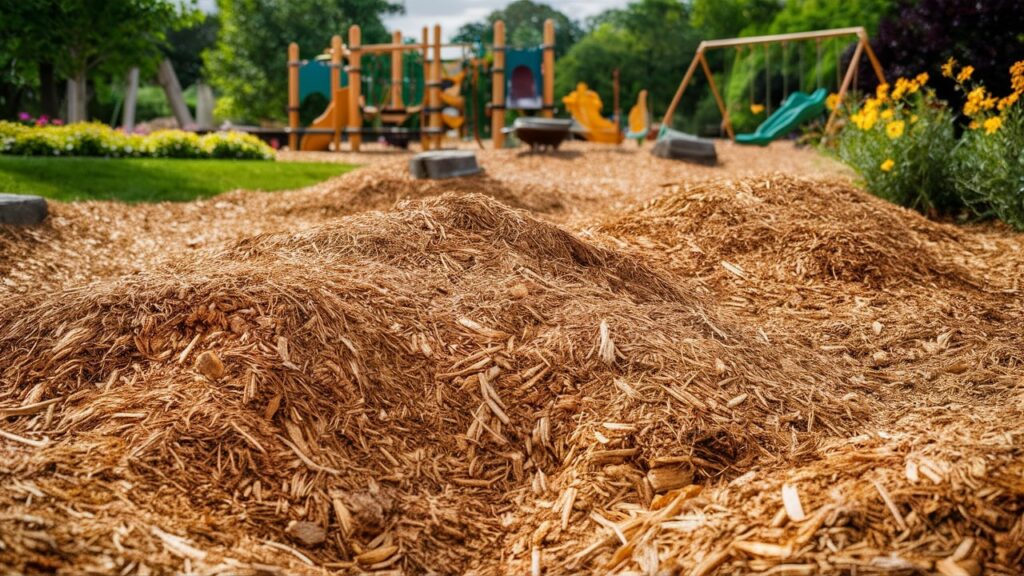For playgrounds, mulch should be at least 6 inches deep for adequate cushioning and fall protection. Proper installation and maintenance are also crucial for ensuring safety.
Playgrounds are a favorite spot for children to play and have fun, but safety is always a top priority. One important aspect of playground safety is the type and depth of mulch used as ground cover. Mulch provides cushioning for falls and reduces injuries, so it’s important to make sure it’s installed correctly.
We’ll discuss the appropriate depth of mulch for playgrounds and why it’s essential to follow installation and maintenance guidelines to keep kids safe. Whether you’re a parent, playground owner, or landscaper, this information will help you make informed decisions about playground safety.

Introduction To Playground Mulch
When it comes to playground mulch, determining the appropriate depth is crucial for safety. By following guidelines and calculations, you can ensure that the mulch is deep enough to provide adequate cushioning and protection for children while they play.
Importance Of Safety Surfacing
Playground mulch is essential for creating a safe environment for children to play and explore. It acts as a protective cushioning layer, reducing the impact of falls and helping to prevent injuries. The proper depth of mulch is crucial for meeting safety standards and ensuring a secure surface for play.
Quality playground mulch also provides a stable and slip-resistant surface, which is particularly important for active play areas. It helps to minimize the risk of slips and falls, offering children a secure foundation for their play activities.
Play And Fun Factor
Aside from safety, playground mulch also contributes to the fun factor of play areas. Its soft and cushioned texture makes it an inviting surface for children to run, jump, and engage in various activities. The natural feel of mulch adds an element of adventure and exploration to playgrounds, encouraging kids to immerse themselves in imaginative play.
Furthermore, playground mulch can enhance the overall aesthetics of the play area, blending seamlessly with the natural surroundings and creating an inviting space for kids to enjoy.
Types Of Playground Mulch
To ensure playground safety, the depth of mulch is crucial. Different types of playground mulch require varying depths, but the standard is at least 6 inches. It’s important to calculate the area of the playground and the amount of mulch needed to prevent injuries from falls.
When it comes to creating a safe and enjoyable playground environment, choosing the right type of mulch is crucial. Playground mulch not only provides a cushioned surface for children to play on, but it also helps to prevent injuries from falls. There are two main types of playground mulch options: wood mulch and rubber mulch alternatives.
Wood Mulch Options
Wood mulch is a popular choice for playgrounds due to its natural appearance and affordability. There are several options when it comes to wood mulch:
- Engineered Wood Fiber: Made from shredded wood fibers, engineered wood fiber mulch offers excellent impact absorption and is ADA compliant. It is also resistant to mold and pests.
- Wood Chips: Wood chips are a cost-effective option that provides good shock absorption. However, they may require more frequent replenishment due to decomposition.
- Pine Bark Nuggets: Pine bark nuggets are a durable and long-lasting mulch option. They provide good impact absorption and have a natural, rustic appearance.
Rubber Mulch Alternatives
If you’re looking for a low-maintenance and long-lasting option, rubber mulch alternatives are worth considering. Here are some popular choices:
- Rubber Mulch: Made from recycled tires, rubber mulch offers superior impact absorption and is highly durable. It is available in various colors and does not decompose like wood mulch.
- Rubber Tiles: Rubber tiles provide a solid and stable surface for playgrounds. They are easy to install and maintain, and offer excellent shock absorption.
- Rubber Mats: Rubber mats are another option for a stable and slip-resistant playground surface. They are ideal for high-traffic areas and can be easily replaced if damaged.
When choosing the right type of mulch for your playground, consider factors such as budget, maintenance requirements, and the specific needs of your play area. Both wood mulch and rubber mulch alternatives provide excellent safety features, so you can create a fun and secure environment for children to enjoy.
Determining The Correct Mulch Depth
When it comes to creating a safe and enjoyable playground environment, determining the correct mulch depth is crucial. Adequate mulch depth helps cushion falls and reduces the risk of injuries. Here’s how to ensure you get it right.
Critical Fall Height Considerations
It’s essential to consider the critical fall height when determining mulch depth. The critical fall height is the highest point from which a child could fall. The mulch depth should be sufficient to cushion a fall from this height, ensuring the safety of the children using the playground.
Calculating Volume Requirements
Calculating the volume of mulch required involves determining the area to be covered and the desired depth. Use the following formula to calculate the volume: Area (in square feet) × Depth (in feet) = Volume (in cubic feet). This will help you determine the amount of mulch needed for the playground.
Installation Best Practices
When it comes to installing deep mulch for playgrounds, it’s important to follow best practices to ensure safety and effectiveness. First, measure the area and calculate the amount of material needed. Then, use proper installation techniques, such as unloading the mulch and spreading it evenly.
Finally, consider the depth of the mulch to ensure it provides adequate cushioning for falls.
When it comes to installing deep mulch for a playground, following the proper installation best practices is crucial. By taking the right steps and using the correct layering techniques, you can ensure a safe and effective playground surface for children to enjoy. In this section, we will explore the preparation steps and layering techniques that will help you achieve optimal results.
Preparation Steps
Before installing deep mulch for your playground, it is important to properly prepare the area. Here are the essential preparation steps:
- Clear the playground area of any debris, such as rocks, sticks, and other objects that could interfere with the installation process.
- Level the ground to create a smooth and even surface. This will help prevent any tripping hazards and ensure the mulch is evenly distributed.
- Consider installing a weed barrier or landscape fabric to prevent weed growth under the mulch. However, keep in mind that it is not necessary if you apply a sufficient amount of mulch.
Layering Techniques
Proper layering techniques are essential for the successful installation of deep mulch for playgrounds. Follow these guidelines to achieve the desired results:
- Start by applying a base layer of playground-grade mulch. This layer should be approximately 6 inches deep to provide adequate cushioning and impact absorption.
- Spread the mulch evenly across the entire playground area, ensuring there are no bare spots or uneven areas.
- Use a rake or shovel to level the mulch and create a uniform surface. This will help prevent any uneven areas that could pose a safety risk.
- Consider adding a top layer of mulch to maintain the desired depth. This will help prolong the lifespan of the mulch and provide continued protection for the playground surface.
By following these installation best practices, you can create a safe and inviting playground surface for children to play on. Remember to regularly inspect and maintain the mulch to ensure its effectiveness and safety over time.
Maintenance For Longevity And Safety
For optimal longevity and safety, deep mulch is essential for playground maintenance. By providing a protective cushioning layer, deep mulch helps absorb impact and reduces the risk of injuries during play. It is important to regularly check and maintain the depth of the mulch to ensure its effectiveness in providing a safe and enjoyable play environment.
Regular Inspections
Regular inspections are crucial to maintaining the safety of a playground area. Inspections should be performed daily, weekly, and monthly to ensure that the mulch is at the appropriate depth and is not compacted or uneven. Daily inspections should focus on removing any foreign objects and checking for any immediate hazards, such as broken equipment or exposed hardware. Weekly inspections should focus on identifying any areas that need replenishment and ensuring that the mulch is evenly distributed. Monthly inspections should focus on identifying any areas that have become compacted and require additional raking or leveling.
Replenishment And Compaction Issues
Replenishment of mulch is essential to maintaining the appropriate depth for safety. As children play and run through the playground, the mulch can become displaced or compacted. It is recommended that the mulch be replenished to the appropriate depth at least once a year. Compaction issues can also arise if the mulch is not raked or leveled regularly. Compacted mulch can lead to a decrease in shock absorption, which can increase the risk of injury. It is essential to rake and level the mulch regularly to ensure that it maintains its proper depth and shock-absorbing properties.
Overall, regular inspections, replenishment, and compaction management are crucial for maintaining the safety and longevity of a playground area. By following these maintenance practices, you can ensure that your playground area remains a safe and enjoyable space for children to play.
Additional Safety Features
Ensure additional safety features by maintaining proper depth of mulch for playgrounds. With a deep layer of mulch, at least 12 inches, you can provide adequate cushioning to reduce the risk of injuries from falls. Regularly check and replenish the mulch to maintain the desired safety level.
When it comes to installing mulch for your playground, ensuring safety is of utmost importance. While deep mulch can help cushion falls, there are additional safety features that can be added to further minimize the risk of injuries. In this article, we will discuss two important safety features that should be considered when installing playground mulch: edge barriers and borders, and weed prevention strategies.
Edge Barriers And Borders
One of the most important safety features to consider when installing playground mulch is to ensure that the mulch stays in place and does not spill over onto other areas. This can be achieved by installing edge barriers and borders. These barriers can be made of various materials such as wood, plastic, or metal, and should be at least 12 inches high to prevent the mulch from spilling over.
Weed Prevention Strategies
Another important safety feature to consider is weed prevention. Weeds can grow through the mulch and create an uneven surface, which can increase the risk of falls. To prevent weeds from growing, a weed barrier should be installed under the mulch. This can be achieved by laying down a layer of landscaping fabric before adding the mulch. Additionally, regular maintenance and weeding should be performed to ensure that the area remains free of weeds.
In conclusion, edge barriers and borders, along with weed prevention strategies, are important safety features to consider when installing deep mulch for your playground. These safety measures can help ensure that the area remains safe for children to play in.
Cost Considerations
When it comes to creating a safe and inviting playground environment, choosing the right surface material is crucial. Deep mulch is a popular option due to its cushioning effect, ability to absorb impact, and natural appearance. However, before making a decision, it’s important to consider the cost implications of using deep mulch for your playground.
Initial Investment
The initial cost of installing deep mulch for a playground can vary depending on several factors. These factors include the size of the playground area, the depth of the mulch layer required, and the type of mulch chosen. It’s essential to calculate the amount of mulch needed accurately to ensure you purchase the right quantity.
To determine the amount of mulch required, measure the area of the playground and multiply it by the desired depth of the mulch layer. Consider using a mulch calculator tool or consulting with a professional to ensure accurate measurements. Once you have determined the amount needed, you can estimate the cost based on the price per cubic yard or bag of mulch.
It’s important to note that while the initial investment in deep mulch may be higher than other playground surfacing options, it provides long-term benefits that justify the cost.
Long-term Upkeep
One of the significant advantages of deep mulch is its low maintenance requirements. Unlike some other playground surfaces, deep mulch does not require frequent replacement or repair. Once properly installed, it can last for several years with minimal upkeep.
However, it’s important to consider the long-term costs associated with maintaining deep mulch. Over time, the mulch may break down and compact, reducing its effectiveness in cushioning falls. Regular inspections and occasional top-ups may be necessary to maintain the desired depth and safety standards.
Additionally, weather conditions and heavy usage can affect the lifespan of the mulch. Heavy rain or extreme temperatures may cause the mulch to deteriorate faster, requiring more frequent replenishment. Considering these factors will help you estimate the long-term upkeep costs and plan your budget accordingly.
In conclusion, while deep mulch for playgrounds may require a higher initial investment compared to other surfacing options, its long-term benefits and low maintenance make it a cost-effective choice. By considering the initial investment and long-term upkeep costs, you can make an informed decision that ensures the safety and enjoyment of children in your playground.
Environmental Impact And Sustainability
When considering playground mulch options, it’s crucial to prioritize environmental impact and sustainability. The choice of mulch can significantly affect the ecosystem and long-term sustainability. Therefore, it’s essential to explore eco-friendly mulch options, as well as the recycling and disposal of old mulch to ensure a positive environmental impact.
Eco-friendly Mulch Options
Choosing eco-friendly mulch is vital for minimizing the environmental impact of playgrounds. Natural mulch materials such as wood chips, bark, and recycled rubber mulch are sustainable options that help in reducing waste and promoting a healthier environment. These materials decompose naturally, enriching the soil and supporting plant growth.
Furthermore, certified organic mulch is an eco-friendly alternative that is free from harmful chemicals and pesticides, ensuring a safe and sustainable playground environment for children.
Recycling And Disposal Of Old Mulch
Proper disposal and recycling of old mulch is essential for maintaining environmental sustainability. Composting old mulch can contribute to the creation of nutrient-rich soil, supporting the growth of new vegetation and minimizing waste. Municipal recycling programs often offer mulch recycling services, allowing old mulch to be repurposed for various landscaping and agricultural applications, reducing the environmental burden of waste disposal.
Diy Vs. Professional Installation
For a playground, installing deep mulch is crucial for safety. While DIY installation can save money, professional installation ensures proper depth and safety compliance. Consider the area size and safety standards before choosing the installation method.
When it comes to installing deep mulch for your playground, you have two options: doing it yourself (DIY) or hiring a professional. Both approaches have their pros and cons, so it’s important to weigh them carefully before making a decision.
Pros And Cons
Let’s take a look at the advantages and disadvantages of each option:
DIY Installation
Pros:
- Cost-effective: DIY installation can save you money as you won’t have to pay for professional services.
- Flexibility: You have complete control over the installation process and can customize it to your specific needs.
- Satisfaction: Successfully completing a DIY project can bring a sense of accomplishment and pride.
Cons:
- Time-consuming: Installing deep mulch can be a time-consuming task, especially if you have a large playground area.
- Physical labor: DIY installation requires physical effort, including lifting and spreading the mulch.
- Limited expertise: Unless you have experience in landscaping and playground safety, there may be a risk of improper installation.
Professional Installation
Pros:
- Expertise: Hiring a professional ensures that the mulch is installed correctly, meeting safety standards and guidelines.
- Time-saving: Professionals have the necessary tools and equipment to complete the installation efficiently.
- Peace of mind: You can rest assured that the mulch will be installed properly, reducing the risk of accidents or injuries.
Cons:
- Cost: Professional installation can be more expensive than doing it yourself, considering the labor and expertise involved.
- Limited customization: Professionals may have a set process and may not be able to accommodate specific customization requests.
- Dependency: You’ll need to rely on the availability and schedule of the contractor, which may cause delays.
Finding The Right Contractor
If you decide to go with professional installation, finding the right contractor is essential. Here are a few tips to help you in your search:
- Research: Look for contractors with experience in playground installation and mulch placement.
- Read reviews: Check online reviews and testimonials to gauge the quality of their work.
- Ask for recommendations: Seek recommendations from friends, neighbors, or local community groups.
- Request quotes: Contact multiple contractors and compare their prices and services.
- Verify credentials: Ensure that the contractor is licensed, insured, and compliant with safety regulations.
By following these steps, you can find a reputable contractor who will provide reliable and professional installation services for your playground mulch.
Case Studies And Success Stories
Discover the success stories of using deep mulch for playgrounds in Austin, Texas. Learn about the benefits of this method and find out how to calculate the amount of mulch needed for your playground project. Improve safety and enhance the play experience with proper ground cover.
Community Playground Projects
Communities across the country have successfully implemented deep mulch for playgrounds, creating safe and sustainable play areas for children. From urban parks to suburban neighborhoods, the use of deep mulch has proven to be a cost-effective and environmentally friendly solution for playground surfacing.
Innovative Design Examples
Many playgrounds have incorporated innovative design elements to maximize the benefits of deep mulch. These designs not only enhance safety but also contribute to the overall aesthetic appeal of the play area. From creative landscaping to themed play structures, these examples showcase the versatility and adaptability of deep mulch in playground design.
Conclusion: Balancing Safety And Fun
To ensure safety and fun, it’s crucial to strike the right balance when determining the depth of mulch for playgrounds. Adequate mulch depth, typically around 6 inches, can effectively cushion falls and reduce the risk of injuries. It’s essential to follow safety guidelines and regularly maintain the mulch to ensure a safe and enjoyable play environment.
Final Thoughts
The safety and fun of a playground are equally important considerations when deciding on the depth of mulch to use. Striking the right balance ensures that children can engage in active play while being protected from potential injuries.
Encouraging Active Play
Deep mulch for playgrounds not only provides a cushioned surface for falls but also encourages children to engage in active and energetic play without the fear of getting hurt. This promotes physical activity and overall well-being among kids.
Frequently Asked Questions
How Much Mulch Do I Need Under A Playset?
To determine the amount of mulch needed under a playset, measure the area and calculate the quantity required. It is important to use playground grade mulch and maintain a proper depth for safety. Avoid using landscape fabric as it can hinder plant growth and nutrient absorption.
Consult a professional for accurate measurements and installation guidance.
How Deep Should Mulch Be For Ground Cover?
For ground cover, the recommended depth for mulch is 2-3 inches. This helps to retain moisture, suppress weed growth, and regulate soil temperature. However, if the area is prone to erosion, a thicker layer of mulch may be necessary. It’s important to avoid piling mulch too high around plant stems or tree trunks, as this can lead to moisture buildup and root rot.
What Is The Fall Height For Playground Mulch?
The fall height for playground mulch depends on the type of equipment being used. Generally, a 6-inch depth of mulch is recommended for equipment up to 8 feet tall, while 12 inches is recommended for equipment up to 10 feet tall.
It is important to follow manufacturer guidelines and local regulations for playground safety.
Should I Put Landscape Fabric Under Playground Mulch?
Landscape fabric is not necessary under playground mulch. It doesn’t block weeds effectively and can hinder the composting process. The correct amount of mulch will prevent weed growth and provide nutrients to the plants. Avoid using landscape fabric for a healthy playground environment.
Conclusion
When it comes to creating a safe and enjoyable playground, deep mulch is essential. By providing a cushioning surface, it helps protect children from injuries caused by falls. Additionally, deep mulch acts as a barrier against weeds and helps retain moisture in the soil.
It is important to calculate the right amount of mulch needed for your playground to ensure optimal safety and functionality. So, make sure to follow the guidelines and recommendations for proper mulch depth to create a fun and safe play area for children.








